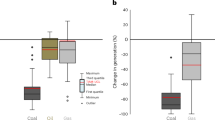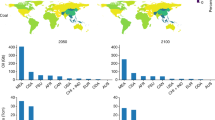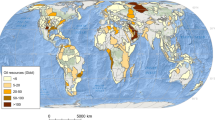Abstract
Despite the current ambivalence of the United States towards the Paris Agreement, national and local jurisdictions across the globe remain committed, and they are seeking ways to increase the ambition and effectiveness of their climate policies. One way forwards could be limiting the production — not just the consumption — of coal, gas and oil. Here we describe the rationale for, and CO2 emissions implications of, limiting oil production. Seven countries have recently imposed such limits, and we develop a case study for a potential addition to this group, the US state of California. We find that by ceasing the issuance of permits for new oil wells, California could reduce global CO2 emissions substantially and also enhance environmental justice in the state.
This is a preview of subscription content, access via your institution
Access options
Access Nature and 54 other Nature Portfolio journals
Get Nature+, our best-value online-access subscription
$29.99 / 30 days
cancel any time
Subscribe to this journal
Receive 12 print issues and online access
$209.00 per year
only $17.42 per issue
Buy this article
- Purchase on Springer Link
- Instant access to full article PDF
Prices may be subject to local taxes which are calculated during checkout



Similar content being viewed by others
Data availability
Source data for Figs. 2 and 3 and Supplementary Figs. 1 and 2 are provided with the paper. Source data for Supplementary Fig. 3 are available from the corresponding author upon reasonable request. Source data for Supplementary Fig. 4 were used under licence for the current study and so are not publicly available; source data for this figure are therefore available from the authors upon reasonable request and with permission of Rystad Energy.
References
Emission Database for Global Atmospheric Research (EDGAR) (European Commission, Joint Research Centre and PBL Netherlands Environmental Assessment Agency, 2015).
Rogelj, J. et al. Scenarios towards limiting global mean temperature increase below 1.5 °C. Nat. Clim. Change 8, 325–332 (2018).
Technologies, Policies and Measures for Mitigating Climate Change Technical Paper 1 (IPCC, 1996).
World Bank, Ecofys & Vivid Economics State and Trends of Carbon Pricing 2017 (World Bank, 2017).
Yang, Z. & Bandivadekar, A. 2017 Global Update: Light-duty Vehicle Greenhouse Gas and Fuel Economy Standards (International Council on Clean Transportation, 2017).
The Emissions Gap Report 2017 (United Nations Environment Programme, 2017).
Suva Declaration on Climate Change (PIDF, 2015).
2017 Climate Change Scoping Plan Update: Resolution 17–46 (California Air Resources Board, 2017).
Decision 1/CP.21: Adoption of the Paris Agreement (UNFCCC, 2015).
Lazarus, M. & Asselt, H. Van. Fossil fuel supply and climate policy: exploring the road less taken. Climatic Change 150, 1–13 (2018).
Whitaker, B. The governor who’s castigating the president on climate change. CBS News (10 December 2017).
State Energy Data System (United States Energy Information Administration, 2017).
Cube Browser Version 1.19 (Rystad Energy, 2017).
Gordon, D. & Wojcicki, S. Drilling Down on Oil: The Case of California’s Complex Midway Sunset Field (Carnegie Endowment for International Peace, 2017).
California Greenhouse Gas Emission Inventory (California Air Resources Board, 2017).
Brandt, A. R. Oil depletion and the energy efficiency of oil production: the case of California. Sustainability 3, 1833–1854 (2011).
Brown, E. G. Executive Order B-55-18 to Achieve Carbon Neutrality (Executive Office, State of California, 2018).
Long, J. C. S. et al. An Independent Scientific Assessment of Well Stimulation in California. Volume I: Well Stimulation Technologies and their Past, Present, and Potential Future Use in California (California Council on Science and Technology, 2016).
Brown, E. G. California Governor Jerry Brown at the National Press Club, Washington D. C. (C-SPAN, 2018).
Green, F. & Denniss, R. Cutting with both arms of the scissors: the economic and political case for restrictive supply-side climate policies. Climatic Change 150, 73–87 (2018).
Krane, J. Climate Strategy for Producer Countries: The Case of Saudi Arabia (Baker Institute for Public Policy of Rice Univ., 2018).
Harstad, B. Buy coal! A case for supply-side environmental policy. J. Polit. Econ. 120, 77–115 (2012).
Fæhn, T., Hagem, C., Lindholt, L., Mæland, S. & Rosendahl, K. E. Climate policies in a fossil fuel producing country: demand versus supply side policies. Energy J. 38, 77–102 (2017).
Collier, P. & Venables, A. J. Closing coal: economic and moral incentives. Oxford Rev. Econ. Policy 30, 492–512 (2014).
Erickson, P. & Lazarus, M. Would constraining US fossil fuel production affect global CO2 emissions? A case study of US leasing policy. Climatic Change 150, 29–42 (2018).
McAdam, D. Social movement theory and the prospects for climate change activism in the United States. Annu. Rev. Polit. Sci. 20, 189–208 (2017).
Piggot, G. The influence of social movements on policies that constrain fossil fuel supply. Clim. Policy 18, 942–954 (2018).
Cheon, A. & Urpelainen, J. Activism and the Fossil Fuel Industry (Routledge, New York, 2018).
Schifeling, T. & Hoffman, A. J. Bill McKibben’s influence on U. S. climate change discourse: shifting field-level debates through radical flank effects. Organiz. Environ. https://doi.org/10.1177/1086026617744278 (2017).
Geels, F. W., Tyfield, D. & Urry, J. Regime Resistance against low-carbon transitions: introducing politics and power into the multi-level perspective. Theory Cult. Soc. 31, 21–40 (2014).
Supran, G. & Oreskes, N. Assessing ExxonMobil’s climate change communications (1977–2014). Environ. Res. Lett. 12, 084019 (2017).
McCright, A. M. & Dunlap, R. E. Defeating Kyoto: the conservative movement’s impact on U. S. climate change policy. Soc. Problems 50, 348–373 (2003).
Mulvey, K. & Shulman, S. The Climate Deception Dossiers (Union of Concerned Scientists, 2015).
Green, F. Anti-fossil fuel norms. Climatic Change 150, 103–116 (2018).
Princen, T., Manno, J. & Martin, P. Ending the Fossil Fuel Era (MIT Press, Cambridge, 2015).
Quast, D. Calls for California to Abandon Fossil Fuels are Counterproductive Nonsense (Energy in Depth, 2018).
Green, F. Transition Policy for Climate Change Mitigation: Who, What, Why and How? (Centre for Climate Economics & Policy, Crawford School of Public Policy, Australian National Univ., 2018).
Metcalf, G. E. The impact of removing tax preferences for US oil and natural gas production: measuring tax subsidies by an equivalent price impact approach. J. Assoc. Environ. Resour. Econ. 5, 1–37 (2018).
Levi, M. A new keystone XL paper is probably wrong. CFR Energy, Security, and Climate https://www.cfr.org/blog/new-keystone-xl-paper-probably-wrong (2014).
Stavins, A. R. California’s crude oil production and its climate change policies. An Economic View of the Environment http://www.robertstavinsblog.org/2018/05/05/californias-crude-oil-production-and-its-climate-change-policies (2018).
2016 Report of California Oil and Gas Production Statistics (DOGGR, 2017).
Annual Energy Outlook 2018 (US Energy Information Administration, 2018).
DrillingInfo Production Query (DrillingiInfo Inc., 2018); https://info.drillinginfo.com
Inventory of U. S. Greenhouse Gas Emissions and Sinks: 1990–2015 (US Environmental Protection Agency, 2017).
IPCC 2006 IPCC Guidelines for National Greenhouse Gas Inventories (IGES, 2006).
Erickson, P. & Lazarus, M. Impact of the Keystone XL pipeline on global oil markets and greenhouse gas emissions. Nat. Clim. Change 4, 778–781 (2014).
Bordoff, J. & Houser, T. Navigating the US Oil Export Debate (Columbia Univ., Center on Global Energy Policy and Rhodium Group, 2015).
Wolvovsky, E. & Anderson, W. OCS Oil and Natural Gas: Potential Lifecycle Greenhouse Gas Emissions and Social Cost of Carbon (US Department of Interior, Bureau of Ocean Energy Management, 2016).
Rajagopal, D. & Plevin, R. J. Implications of market-mediated emissions and uncertainty for biofuel policies. Energy Policy 56, 75–82 (2013).
The Impacts of U. S. Crude Oil Exports on Domestic Crude Production, GDP, Employment, Trade, and Consumer Costs (ICF and Ensys, 2014).
Baffes, J., Kose, M., Ohnsorge, F. & Stocker, M. The Great Plunge in Oil Prices: Causes, Consequences, and Policy Responses (Social Science Research Network, 2015).
California’s 2017 Climate Change Scoping Plan (California Air Resources Board, 2017).
Long, J. C. S. et al. An Independent Scientific Assessment of Well Stimulation in California: Volume II: Potential Environmental Impacts of Hydraulic Fracturing and Acid Stimulations (California Council on Science and Technology, 2016).
Long, J. C. S. et al. An Independent Scientific Assessment of Well Stimulation in California: Volume III: Case Studies of Hydraulic Fracturing and Acid Stimulations in Select Regions: Offshore, Monterey Formation, Los Angeles Basin and San Joaquin Basin (California Council on Science and Technology, 2016).
CalEnviroScreen 3.0. (OEHHA, 2017).
Trout, K. The Sky’s Limit California: Why the Paris Climate Goals Demand that California Lead in a Managed Decline of Oil Extraction (Oil Change International, 2018).
Environmental Justice & Healthy Communities (California State Department of Justice, 2018); https://oag.ca.gov/environment/communities
Gerarden, T., Reeder, W. S. & Stock, J. H. Federal Coal Program Reform, the Clean Power Plan, and the Interaction of Upstream and Downstream Climate Policies (National Bureau of Economic Research, 2016).
The Economics of Coal Leasing on Federal Lands: Ensuring a Fair Return to Taxpayers (White House Council of Economic Advisers, 2016).
Copenhagen Economics The Future of Fossil Fuels: How to Steer Fossil Fuel Use in a Transition to a Low-Carbon Energy System (Energy Transitions Commission, 2017).
Jaccard, M., Hoffele, J. & Jaccard, T. Global carbon budgets and the viability of new fossil fuel projects. Climatic Change 150, 15–28 (2018).
Piggot, G., Erickson, P., van Asselt, H. & Lazarus, M. Swimming upstream: addressing fossil fuel supply under the UNFCCC. Clim. Policy 18, 1189–1202 (2018).
Steininger, K. W., Lininger, C., Meyer, L. H., Muñoz, P. & Schinko, T. Multiple carbon accounting to support just and effective climate policies. Nat. Clim. Change 6, 35–41 (2016).
Brown, E. G. Remarks of Governor Jerry Brown at America’s Pledge at COP23 (America’s Pledge, 2017); https://www.youtube.com/watch?v=gXyFW9_EJ_U
California Governor Brown Announces Global Climate Action Summit in San Francisco In September 2018 (Office of the Governor, 2017).
About the Summit (Global Climate Action Summit, 2018); https://globalclimateactionsummit.org/about-the-summit
Kartha, S., Caney, S., Dubash, N. K. & Muttitt, G. Whose carbon is burnable? Equity considerations in the allocation of a “right to extract”. Clim. Change 150, 117–129 (2018).
Caney, S. Climate Change, Equity, and Stranded Assets (Oxfam America, 2016).
Lenferna, G. A. Can we equitably manage the end of the fossil fuel era? Energy Res. Soc. Sci. 35, 217–223 (2018).
Tyndall, J. Can limiting oil production make good climate policy? In 2018 Global Climate Action Summit (SEI and NextGen Policy, 2018).
Brown, E. G. Letter from Edmund G. Brown Jr, Governor of California, to the Honorable Ryan Zinke, Secretary, U. S. Department of Interior (Office of the Governor, 2018).
Crude Oil Production (US EIA, accessed 31 July 2017); https://www.eia.gov/dnav/pet/pet_crd_crpdn_adc_mbbl_a.htm
Bahreinian, A. et al. Transportation Energy Demand Forecast, 2018–2030 (California Energy Commission, 2017).
Erickson, P., Down, A., Lazarus, M. & Koplow, D. Effect of subsidies to fossil fuel companies on United States crude oil production. Nat. Energy 2, 891–898 (2017).
Acknowledgements
The authors thank D. Broekhoff, D. Lashof, D. Rajagopal, C. Shearer and S. Shonkoff for helpful comments on this manuscript; E. Yehle for editing support; and F. Ackerman, M. Inman, G. Karras, M. Masnadi, G. Muttitt and K. Trout for helpful conversations about data and methodology. Support for this research was provided by the 11th Hour Project of the Schmidt Family Foundation.
Author information
Authors and Affiliations
Contributions
P.E., M.L. and G.P. designed the research. P.E. conducted the analysis. P.E. wrote the manuscript with contributions from M.L. and G.P.
Corresponding author
Ethics declarations
Competing interests
The authors declare no competing interests.
Additional information
Publisher’s note: Springer Nature remains neutral with regard to jurisdictional claims in published maps and institutional affiliations.
Supplementary Information
Supplementary Information
Supplementary Tables 1-2, Supplementary Figures 1-4, Supplementary References
Supplementary Data 1
Source data for Fig. 2, Fig. 3, Supplementary Figure 1, and Supplementary Figure 2, as described in the "data availability" statement
Rights and permissions
About this article
Cite this article
Erickson, P., Lazarus, M. & Piggot, G. Limiting fossil fuel production as the next big step in climate policy. Nature Clim Change 8, 1037–1043 (2018). https://doi.org/10.1038/s41558-018-0337-0
Received:
Accepted:
Published:
Issue Date:
DOI: https://doi.org/10.1038/s41558-018-0337-0
This article is cited by
-
The atlas of unburnable oil for supply-side climate policies
Nature Communications (2024)
-
Applying earth system justice to phase out fossil fuels: learning from the injustice of adopting 1.5 °C over 1 °C
International Environmental Agreements: Politics, Law and Economics (2024)
-
Understanding supply-side climate policies: towards an interdisciplinary framework
International Environmental Agreements: Politics, Law and Economics (2024)
-
Collective action lessons for the energy transition: learning from social movements of the past
Sustainability Science (2024)
-
Development transitions for fossil fuel-producing low and lower–middle income countries in a carbon-constrained world
Nature Energy (2024)



